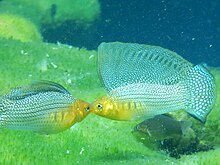Poecilia velifera
| Yucatan molly | |
|---|---|

| |
| Males sparring in the wild | |
| Scientific classification | |
| Domain: | Eukaryota |
| Kingdom: | Animalia |
| Phylum: | Chordata |
| Class: | Actinopterygii |
| Order: | Cyprinodontiformes |
| Family: | Poeciliidae |
| Genus: | Poecilia |
| Species: | P. velifera
|
| Binomial name | |
| Poecilia velifera (Regan, 1914)
| |
| Synonyms[2] | |
|
Mollienesia velifera Regan, 1914 | |
Poecilia velifera, known as the Yucatan molly and also as the giant sailfin molly amongst aquarists,
It is outwardly similar to the
If the males spread their dorsal fins in display, these have a distinct fan or
In the aquarium
Especially small strains are suitable for keeping in an
They are bred like other mollies; in line with their general requirements, this is somewhat more difficult than in related species. It is especially hard to get males to grow their spectacular fins. Professional breeders often separate males and females in winter, so that they are eager to breed in spring. Young can then, climate permitting, grow in spacious outdoor basins during summer.
Like other Poecilia, they are prone to hybridization with their relatives. Not infrequently, crosses are attempted with the sailfin molly to breed a hardier fish. This is generally not very successful, and should not be attempted, as purebred Yucatan mollies are often quite hard to find, and hybrids will not have as massive dorsal fins as these. Several color variants are also available; these usually do not attain the large size of wild-type fish and may have been crossbred with P. latipinna.
Reminder
External links
![]() Media related to Poecilia velifera at Wikimedia Commons
Media related to Poecilia velifera at Wikimedia Commons

